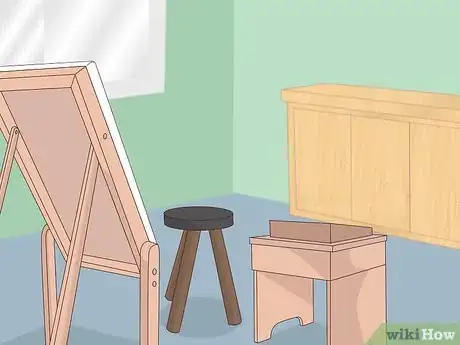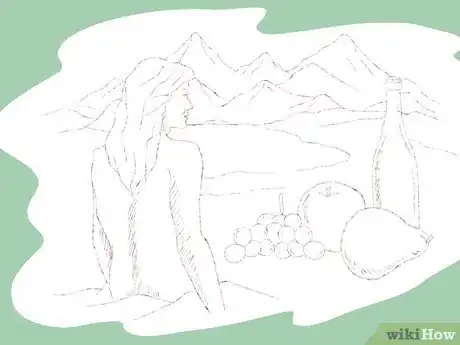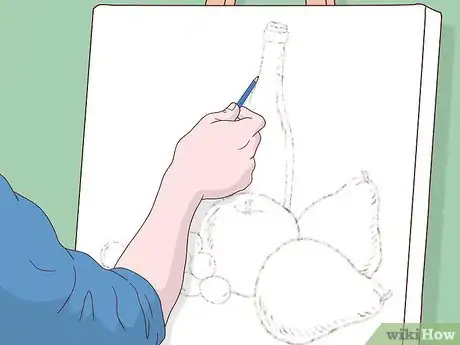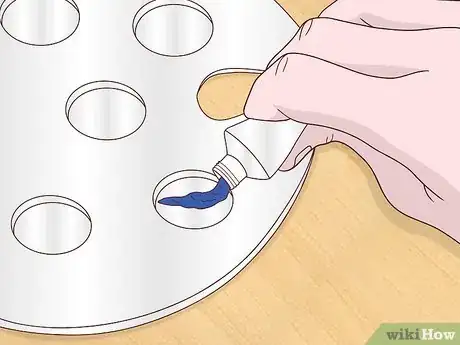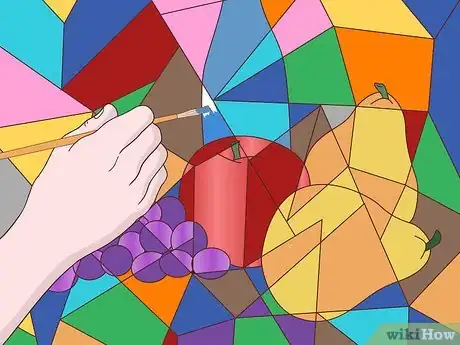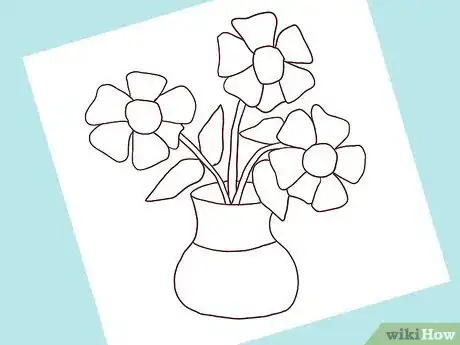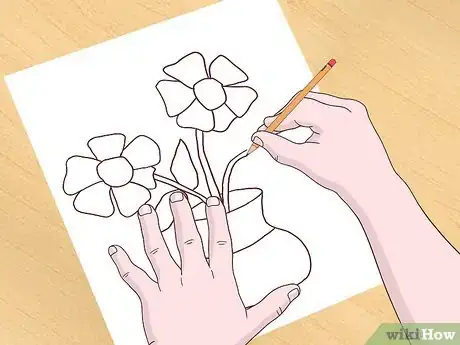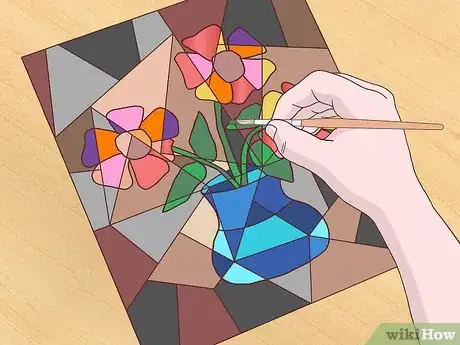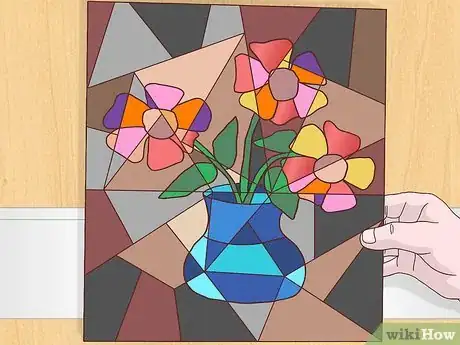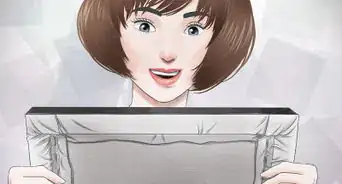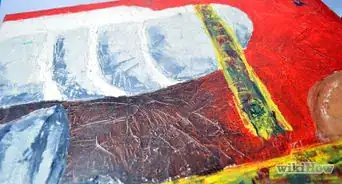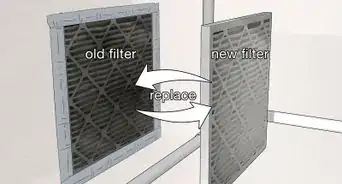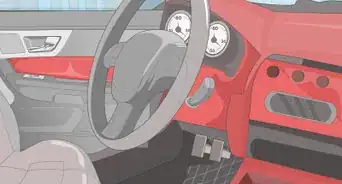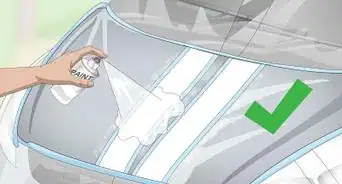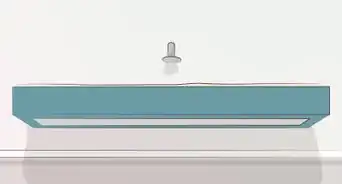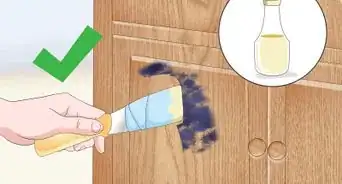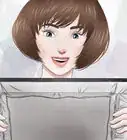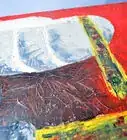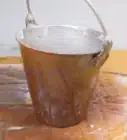This article was co-authored by Kelly Medford. Kelly Medford is an American painter based in Rome, Italy. She studied classical painting, drawing and printmaking both in the U.S. and in Italy. She works primarily en plein air on the streets of Rome, and also travels for private international collectors on commission. She founded Sketching Rome Tours in 2012 where she teaches sketchbook journaling to visitors of Rome. Kelly is a graduate of the Florence Academy of Art.
There are 11 references cited in this article, which can be found at the bottom of the page.
wikiHow marks an article as reader-approved once it receives enough positive feedback. This article received 14 testimonials and 83% of readers who voted found it helpful, earning it our reader-approved status.
This article has been viewed 250,322 times.
Cubism is a style of painting that originated with Georges Braque and Pablo Picasso between 1907 and 1914.[1] The Cubist style sought to show the two-dimensional nature of the canvas. Cubist artists fractured their objects into geometric forms and used multiple and contrasting perspectives in a single painting. It was called Cubism when Louis Vauxcelles, a French art critic, called the forms in Braque’s work “cubes.” Creating your own Cubist style painting can be a fun way to connect with art history and look at painting with a fresh perspective.
Steps
Preparing to Paint Your Cubist Art
-
1Prepare your workspace. When doing any kind of art, you want to make sure you have a clean workspace. Choose an area with plenty of natural light and either a table or an easel to hold your canvas.
- Lay down newspaper in your work area to keep it clean.
- Use a glass of water and a soft rag to clean your paintbrushes between colors.
-
2Choose your canvas.[2] For convenience it is simplest to buy a pre-made canvas, but you can stretch your own. Size and shape are up to you, but larger or mid-sized canvases are easiest to paint.
- If you just want to practice, you can also create paintings on large multi-media art paper.
- Your local art supply store should carry paper and canvas.
Advertisement -
3Gather your remaining materials. To create your Cubist-style painting, you’ll need sketching materials, a canvas, brushes, paint, and plenty of inspiration.
- You can use any type of paint to achieve a Cubist style, but acrylic works well, especially for beginners. Acrylic paints are versatile, often less expensive than oil paints, and make it easier to create crisp lines.[3]
- Pick paintbrushes that are labeled for acrylic paints. Get a few different sizes for versatility while you paint.
- Make sure you have a pencil and gum eraser on hand to sketch before you begin to paint.
- You may also need a ruler or yardstick to help guide your lines and make them crisp and straight.
-
4Pick your subject. Though Cubism was an abstracted form of modern art, most Cubist painters drew from real life in their work.[4] Though their paintings were highly fragmented and geometric, a subject was still discernible within them.
- Decide whether you want to paint a human figure, a landscape, or a still life.
- Choose something that you can look at and study in real life while you are painting. For example, if you want to do a figure, see if a friend can pose for you. If you’d like to paint a still life, arrange a group of objects or an object, like a musical instrument, in front of you.
-
5Sketch your subject in pencil onto your canvas.[5] This will be the guide for your painting. Don’t worry about capturing the details. Use broad, gestural strokes to capture the movement of whatever it is you are studying.
- Once you have a general sketch, use your ruler to sharpen the edges.
- In any place you’ve sketched soft, rounded lines, go back over them and change them into sharp lines and edges.
- For example, if you’re sketching a person, you might go over the rounded line of the shoulder and make it look more like the top of a rectangle.
Putting Your Idea on Canvas
-
1Add more lines. You want the geometry of your painting to be more than just a basic outline of your subject. Think about different ways you can further break down the shapes in your painting.
- Look at the light. Instead of shading and blending, in Cubism, you will use the light to create shapes. Outline, in geometric shapes, where the light falls in your painting.
- Also, use geometric lines to show where you would generally shade in a painting.
- Don’t be afraid to overlap your lines.
-
2Create your color palette. Within Cubism, artists focused on the form in a painting, rather than color.[6] They often used neutral browns and blacks. In Braque’s painting “Candlestick and Playing Cards on a Table,” you can see his use of neutrals to emphasize form.[7]
- If you want to use bright colors, choose to use between one and three main bright colors so that your painting retains its striking geometry.
- You can also use a monochromatic palette in a single color family. For example, Picasso did many paintings mainly in shades of blue.
- Put your paints onto your palette or a paper plate in front of you. Use white to make shades lighter. Mix the colors that you want.
-
3Paint over your sketch.[8] The sketch should be the guide for your painting. Use darker colors to thinly outline the individual geometric shapes that you created while sketching.[9] Unlike in a traditional painting, you don’t need to blend all your colors into each other. You want your lines to be distinct.
- With acrylic paints, you can layer colors to make your paintings feel more dimensional.
- If you need to do so, use your ruler to guide your paintbrush, like you did your pencil. You want your paint lines to be just as crisp as your pencil lines.
Making a Cubist Painting for Kids
-
1Pick kid-friendly art materials.[10] You want to choose materials that kids will find easy to work with and that won’t create a large mess.
- Washable acrylic paints work well for painting with kids. You can also create a “painting” masterpiece with markers, crayons, or colored pencils.
- Choose a large sheet of art paper or a notebook of paper to make your Cubist style painting.
- You’ll also need paintbrushes, and a pencil and eraser.
EXPERT TIPKelly Medford is an American painter based in Rome, Italy. She studied classical painting, drawing and printmaking both in the U.S. and in Italy. She works primarily en plein air on the streets of Rome, and also travels for private international collectors on commission. She founded Sketching Rome Tours in 2012 where she teaches sketchbook journaling to visitors of Rome. Kelly is a graduate of the Florence Academy of Art.Professional Painter
 Kelly Medford
Kelly Medford
Professional PainterCubist paintings are a great way to stretch your kids' artistic imaginations. Kelly Medford, a plein air painter, says: “With kids, you want to encourage them with whatever they make, give them the skills to keep developing, and always challenge them. Teaching them new skills can help them to refine what they already know.”
-
2Choose the subject for your piece. This could be something simple like a vase of flowers or even a single flower.[11] You’ll first draw this subject, and then use lines to break it up.
- Choose something you have on hand. You want to practice drawing from life instead of just drawing from your imagination.
- Practice making small sketches of your subject in a sketchbook. You want to decide exactly how you will draw it for your final painting.
-
3Sketch your final subject drawing on your art paper. You should draw lightly with your pencil so that if you make a mistake, you can erase it and start again.
- As you are sketching, remember that your drawing doesn’t have to be completely realistic.
- It’s okay to overlap lines and exaggerate features. You’re just going to make it even more abstract.
-
4Break up bigger shapes in your drawing. Use a pencil and a ruler to draw straight lines in all directions. Use your creativity to decide where to place them.
- You don’t want large areas of blank space in your drawing.
- You also don’t want to create too many areas with a bunch of tiny geometric shapes.
-
5Paint the shapes in your drawing. You want to paint each of the sections you created individually. Experiment with using your brush in different directions to create texture.
- Use black or brown paint to create thin outlines around the shapes you made.
- Try to stick to using only a few different colors.
-
6Display your creation. Add any final touches, and remember to sign your name on the bottom of your Cubist style painting.
- These paintings make great decorations for children’s bedrooms.
- They are also good gifts for Mother’s Day, Father’s Day, or Grandparents’ Day.
Community Q&A
-
QuestionCould I use poster colors for abstract art?
 Community AnswerOf course! Art is anything you want it to be, especially when it's abstract. There are no limits to what materials can be used for creating. Use poster color, lipstick, mud, anything!
Community AnswerOf course! Art is anything you want it to be, especially when it's abstract. There are no limits to what materials can be used for creating. Use poster color, lipstick, mud, anything! -
QuestionCan one convey an emotion through abstracts? If yes, then how?
 Community AnswerAbstract art is meant to be surreal. And yes, it can be used to convey a wide range of emotion, just like other forms of art. By the use of warm colors, one can express warmth and motion in the art piece, and so on. A single art piece can be interpreted by different people in different ways and you can create an art piece worthy of a deep thought.
Community AnswerAbstract art is meant to be surreal. And yes, it can be used to convey a wide range of emotion, just like other forms of art. By the use of warm colors, one can express warmth and motion in the art piece, and so on. A single art piece can be interpreted by different people in different ways and you can create an art piece worthy of a deep thought. -
QuestionIs there a lot of shading in Cubism?
 Community AnswerIn fact, there is no shading in cubism. It's just a matter of painting in geometric pieces.
Community AnswerIn fact, there is no shading in cubism. It's just a matter of painting in geometric pieces.
References
- ↑ http://www.metmuseum.org/toah/hd/cube/hd_cube.htm
- ↑ http://www.parkablogs.com/content/choosing-right-canvas-your-paintings-and-artworks
- ↑ http://willkempartschool.com/what-is-the-difference-between-oils-vs-acrylic-paints/
- ↑ https://www.moma.org/learn/moma_learning/themes/cubism
- ↑ http://www.cansonstudio.com/drawing-learning-sketch-life
- ↑ http://www.pablopicasso.org/cubism.jsp
- ↑ http://www.metmuseum.org/toah/works-of-art/1997.149.12/
- ↑ http://www.craftsy.com/blog/2015/07/acrylic-painting-techniques-for-beginners/
- ↑ http://emptyeasel.com/2007/10/17/what-is-cubism-an-introduction-to-the-cubist-art-movement-and-cubist-painters/
About This Article
To do a Cubist style painting, begin by choosing a subject that appeals to you. Some possibilities include a still life with flowers or a self-portrait—although Cubism is an abstract style, most Cubist painters work from life. Once you’ve decided what to paint, sketch it on the canvas in pencil. Then, look for ways to break the shapes down into more basic geometric forms. Finally, settle on a color palette for your painting—anything from shades of blue to an entire rainbow—and begin filling in the shapes you’ve created with paint. For more beginner-friendly tips, such as how to do Cubist paintings if you’re a kid, keep reading!
